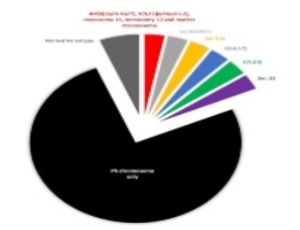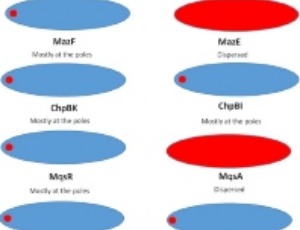Loading
Archives of Molecular Biology and Genetics
ISSN: 2831-6754
Most Read Articles
Karyotypic Profile of Chronic Myeloid Leukemia in Patients Diagnosed at Tertiary Level in Afghanistan
Abdul Hadi Saqib , Samuel Sharif , Ahmad Walid Yousufzai , Najla Nasir , Sarah Noor , Sahar Noor , Abdul Jamil Rasooli , Ahmad Shekib Zahier , Ramin Saadaat , Haider Ali Malakzai , Abdul Sami Ibrahimkhil , Maryam Ahmad , Zeeshan Ansar Ahmed
Balanced translocation resulting in fusion of the Abelson gene (ABL1) from chromosome 9q34 with the breakpoint cluster region (BCR) gene on chromosome 22q11.2 is the pathognomonic molecular driver of CML. The resulting BCRABL 1 fusion gene is both the diagnostic as well as therapeutic target of CML. The first agent with tyrosine kinase inhibitor activity that was licenced in 2000 for treatment of CML patients, was Imatinib, gradually followed by multiple agents with higher efficacy.
Arch Mol Biol Genet, 2022, Volume 1, Issue 1, p1-7 | DOI: 10.33696/genetics.1.001
Constitutively Active Death Receptor Induces Apoptosis in Mammalian Cells
Peterson K , Palmer B , Christensen C , Bailey S , Mizrachi D
Apoptosis is a physiological response in development and homeostasis of metazoans. Apoptosis is triggered during pathological events as a means to renew affected tissues and eliminate cancer cells. The immune system regulates the extrinsic pathway of apoptosis, where signals such as TNFα or displayed ligands on the surface of immune cells trigger signal cascades by death receptors present on targeted cells. Therapeutics, like Doxorubicin, lead to apoptosis successfully.
Arch Mol Biol Genet, 2022, Volume 1, Issue 1, p20-28 | DOI: 10.33696/genetics.1.004
Actors of ROS Homeostasis in Stigmatic Cells Essential for Plant Reproduction
Chie Kodera , Isabelle Fobis-Loisy
Reactive oxygen species (ROS) play important roles during development and responses to external stimuli. In Brassicaceae, the stigma epidermis accumulates a large amount of ROS. Moreover, regulating the stigmatic ROS status is crucial for Self-incompatibility (SI) mechanisms, to ensure self-pollen rejection while promoting compatible pollen. Here, scanning our transcriptomic data in light of recent advances in the Brassicaceae SI system, we identified Class III peroxidases that are highly expressed in mature stigma and might regulate stigma ROS homeostasis.
Arch Mol Biol Genet, 2022, Volume 1, Issue 2, p34-42 | DOI: 10.33696/genetics.1.006
SARS-CoV-2 Mutations, Diagnosis and Their Concern
Yakup Artik , Nevra Pelin Cesur , Nelisa Türkoğlu Laçin
The first case is described in Wuhan city of China in December 2019 and the disease (COVID-19) continues to pose threat to global health all over the world affecting more than approximately 476 million confirmed cases and 6 million deaths. Reliable and effective methods are taken a critical role such as real-time reverse transcriptase (RT)-PCR test as a gold standard method, serological tests, and reverse transcriptase loopmediated isothermal amplification (RT-LAMP) method is chosen firstly.
Arch Mol Biol Genet, 2022, Volume 1, Issue 2, p57-65 | DOI: 10.33696/genetics.1.008
Commentary on "Type II Toxin-antitoxin Systems Have a Peculiar Localization in Escherichia Coli Cells"
Alexander Mager , Hanna Engelberg-Kulka
Bacterial Toxin-Antitoxin (TA) modules were extensively studied. They are located on extra chromosomal genetic elements as well as on bacterial chromosomes. They carry two genes. One encoding for the toxin, and the other for the antitoxin. The toxin is a stable protein, while the antitoxin is either RNA or a labile protein. They are divided into six groups, among them group II is the most studied.
Arch Mol Biol Genet, 2022, Volume 1, Issue 2, p66-68 | DOI: 10.33696/genetics.1.009
Risk Management Implemented by Turkey during the COVID-19 Pandemic Disaster
Nehir Varol , Yakup Artik , Timur Gültekin
The coronavirus (COVID-19) outbreak occurred in China and spread to the whole world in a short period of time. The WHO (World Health Organization) named the viral disease as COVID-19 (Novel Coronavirus, SARS-CoV-2) on February 11, 2020.
Arch Mol Biol Genet, 2022, Volume 1, Issue 2, p69-83 | DOI: 10.33696/genetics.1.010
About Scientific Archives
Scientific Archives is a global publisher initiated with the mission of ensuring equal opportunity for accessing science to research community all over the world. Spreading research findings with great relevance to all channels without any barrier is our goal. We want to overcome the challenges of Open Access with ensured quality and transparency.
